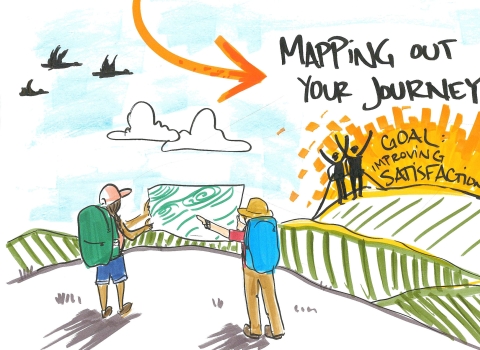Asheville, N.C. – While a frog trying to safely cross a busy highway makes for a classic video game, in real life it’s a losing battle for the frog, who doesn’t get three lives.
Wetlands are home to myriad small animals – snakes, frogs, even lemmings – and when wetlands are bisected by a highway, crossing that road poses risks not only to individual animals, but the well-being of the entire population if enough individuals are killed. While deer and bear on the road quickly get the attention of drivers, few may notice these smaller animals crossing the road.
Over the years, Mike Knoerr has worked with small animals across western North Carolina with several organizations, including The Nature Conservancy, the federal National Resources Conservation Service, and Tangled Bank Conservation, an Asheville-based conservation organization. As a biologist with Tangled Bank Conservation, he was In the midst of field work at a study site in western North Carolina where he noticed a high amount of roadkill in a particular stretch of highway dividing patches of wetlands. He raised this issue with U.S. Fish and Wildlife Service biologist Susan Cameron, setting in motion a chain of events leading to the N.C. Department of Transportation’s recent installation of a passage allowing animals to safely cross the road.
“When we think about animals and roads, we often think about vehicle-animal collisions, which can be costly to both people and wildlife. However, roads can also isolate animals from important habitats and food sources,” said Kevin Hining, the NCDOT environmental officer working on the project. “This project offers NCDOT a chance to work with several partners to reduce animal mortalities and connect two unique habitats. It’s also a great opportunity to evaluate this type of structure structure
Something temporarily or permanently constructed, built, or placed; and constructed of natural or manufactured parts including, but not limited to, a building, shed, cabin, porch, bridge, walkway, stair steps, sign, landing, platform, dock, rack, fence, telecommunication device, antennae, fish cleaning table, satellite dish/mount, or well head.
Learn more about structure , which hasn’t been used in North Carolina before. If successful, it may lead to future uses in other locations.”
The passage isn’t a grandiose animal bridge over the highway, but rather a small, simple tunnel beneath it – concrete bottom and sides with a grated metal top allowing sunlight through. The casual driver likely won’t notice anything more than a gentle break in the rhythm of the road. Both entrances to the tunnel will have fencing guiding animals toward the tunnel.
The design stems from lessons learned by the Ohio Department of Transportation, which installed a tunnel designed for animal movement beneath a state highway. Ohio University researchers determined the passage was falling short of expectations and it was replaced with an off-the-shelf road crossing trench more likely to be found on an industrial site. The general-purpose trench proved far more successful and is the design the NCDOT is using.
“We are grateful to the staff at the North Carolina Department of Transportation,” said Service biologist Laura Fogo. “This is an excellent example of how a community of partners leveraged labor and expenses to protect unnoticed wildlife in need."
By providing engineering and installation services, the NCDOT was the lynchpin agency for the effort, though several organizations came together to pull-off the project. The U.S. Fish and Wildlife Service provided technical assistance and funding for the materials through its Partners for Fish and Wildlife habitat restoration program. The N.C. Wildlife Resources Commission provided technical assistance; The Nature Conservancy provided site access and will help with maintenance; and Tangled Bank Conservation purchased materials and assisted with installation. To gauge the effectiveness of the tunnel, the Service, The Nature Conservancy, the N.C. Wildlife Resources Commission, and Tangled Bank Conservation will monitor the road for roadkill and use trail cameras to document use of the passage by small animals.





